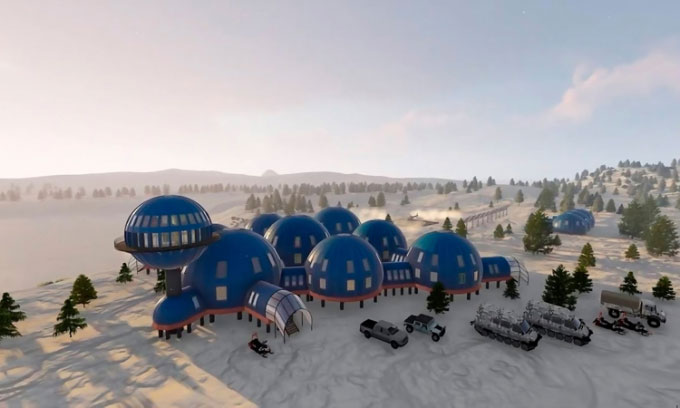Project to build the world's first green energy arctic station
Scientists plan to build a year-round research station in the Arctic using a combination of wind, solar and hydrogen energy.
The team at the Moscow Institute of Physics and Technology (MIPT) plans to start a project to build a $27 million Snezhinka (Snowflake) research station on the Yamal peninsula, the center of Russian gas production, in 2024, Siberian Times on December 20 reported. The structure, described as the International Space Station (ISS) on the ground, is shaped like a snowflake with seven large dome-shaped structures connected by corridors.

Design of the research station Snezhinka.
Snezhinka will be built near a large lake in the windy Jade Valley, between the Rai-Iz and Dinosaur mountain ranges, about 30 kilometers from the village of Kharp. It takes about two hours to drive from Salekhard Airport to the station.
The dome-shaped residences with everything necessary such as residence, gym, conference room, laboratory, maintenance room, can accommodate 80 people at the same time. The Russian scientists plan to operate the station year-round by combining wind, solar and hydrogen energy - produced by electrolysis. This will be essential during polar night - a period of darkness for many weeks.
This is the first attempt to build a fully autonomous science station using green energy, according to Yury Vasiliev, executive director of MIPT's Institute of Arctic Technology.
"There's no facility in the world like Snezhinka. The closest thing is the Belgian Princess Elisabeth station in Antarctica, which is powered by small wind turbines and solar cells. They don't have hydrogen energy, even though hydrogen storage is underway. is planned. Another important thing is that all stations in Antarctica only operate for 3 or 4 months, during the polar day. Meanwhile, Snezhinka will be a year-round operating base in the Arctic," said Yuri Vasiliev. said.
The scientists aim to turn Snezhinka into an international research platform, focusing on applied technology in renewable energy and hydrogen. Other projects include geomagnetic and astronomical observatories, environmental monitoring stations and facilities for testing new engineering solutions in the permafrost.
An emergency diesel generating station will be designed as a backup power source, according to Vailiev. Therefore, it is likely that the project needs to be implemented with diesel support until the station switches to green energy. Another renewable energy station is expected to spring up in the Murmansk region, northwest Russia. In addition, the UAE has also planned a similar project.
- Video: The world's largest green data center in the Arctic Circle
- Google spends $ 1 billion on green energy
- Russia relocated urgently the Arctic research station
- New York will build composting islands
- Huge ski field on the roof of the green energy plant in Denmark
- Scientists worry because weed is growing in the Arctic
- It sounds crazy, but this hundred billion dollar project could save the Earth
- The research station is at the end of the world
- Towards a green economy, green energy
- Hanoi will have more green parks in 2013
- China plans to build a new space station
- NASA celebrates 40 years of the first space station project
 Norway built the world's tallest wooden tower
Norway built the world's tallest wooden tower Kremlin
Kremlin Ashurbanipal: The oldest royal library in the world
Ashurbanipal: The oldest royal library in the world Decoding the thousand-year construction of Qin Shihuang shocked the world
Decoding the thousand-year construction of Qin Shihuang shocked the world